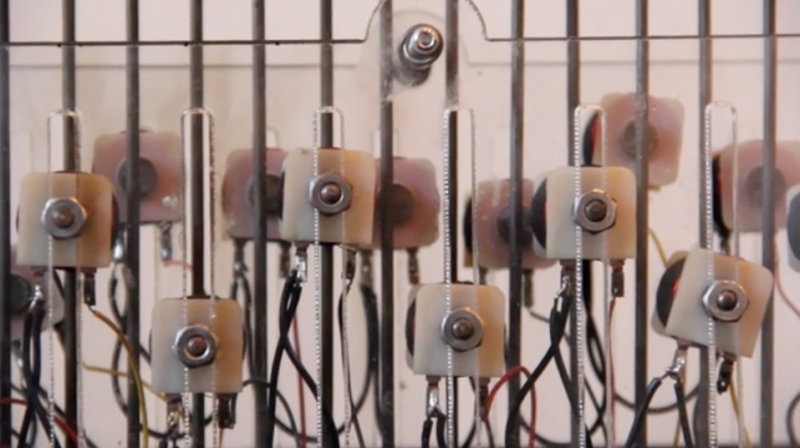Normally you’d expect the sound of a pipe organ to come from something gigantic. [Matthew Steinke] managed to squeeze all of that rich melodic depth into an acoustic device the size of a toaster (YouTube link) which uses electromagnetism to create its familiar sound.
[Matthew ’s] instrument has a series of thin vertical tines, each coupled with a small MIDI controlled electromagnet. As the magnet pulses with modulation at a specific frequency, the pull and release of the tine causes it to resonate continuously with a particular tone. The Tine Organ is capable of producing 20 chromatic notes in full polyphony starting in middle C and can be used as an attachment to a standard keyboard or a synthesizer app on a smart phone. The classic style body of the instrument is made out of mahogany and babinga and houses the soundboard as well as the mini microcontroller responsible for receiving the MIDI and regulating the software oscillators sending voltage to the magnets.
[Matthew’s] creation is as interesting to look at as it is to listen to, so I’d recommend checking out the video below to hear the awesome sound it produces:
















That’s really awesome!
nice instrument, could we hack it to use quartz crystals to make the vibrations?
Agreed, very awesome project.
And a very good write up Sarah.
But …
A schematic? A paragraph or two about the tech inside? ANY kind of documentation AT ALL?
I find projects/videos like this very frustrating.
I was thinking that too. I was disappointed when I saw the link was just to the YouTubes.
me three. looks great, can’t replicate:/
Sure you can replicate it. I’ve been poking around with similar things for decades. You can definitely do this and it’s a beautiful implementation. There have been instruments like this for a very long time. He could feed the drivers with any signal, using each tine setup as transducer, reverb and high-Q bandpass filter at the same time.
I wonder if you could do this with a single electromagnet, and tuned tines…
I agree, it would be more interesting.
I’m no musician, but…. I wonder if the resonant “pipe organ” sound has at least something to do with the driven tines creating tones in the surrounding ones? Beautiful sound in any case…
Found this link but not much more info. http://octant.tumblr.com/
Great alliteration in the headline. Great sound from that surprisingly small instrument too.
Wonder if the tines get hot from the vibrations or from eddy currents. Very cool project.
Wonderful tone, it gives one an inkling of what the Chorachello sounded like. Turn of the last century, it was non amplified piano strings energized by magnets and generated tones (think telharmonium). Pure tones close to sine, and the bass was big tines several to a piano sized soundboard.
I’ve said it before and I’ll say it again but shut up and take my money!
I tested it out with one electromagnet and a tine and an experimental second tine is not in a resonant length with the other tine so in the video it does nothing. It’s run by an arduino tone library playing the resonant frequency.
It alternates between playing the resonant frequency for one second and half the resonant frequency for one second. If you play half the resonant frequency you get a nice little harmony.
The tine is not tuned to anything specific i just banged it and analysed the sound with a spectrum analyzer to see what frequency it resonated at.
The electromagnet is a solenoid from a printer or something with a metal core inside it and a transistor drives it of 12 volts.
It sounds pretty nice, now i just need like 20 more electromagnets and a midi shield to make a whole instrument.
https://www.youtube.com/watch?v=T47cgbxZk48
More info on the thing: http://www.synthtopia.com/content/2014/11/18/the-tine-organ/
Hi folks I’m Riley, a member of the atxhackerspace in Austin ( http://www.facebook.com/ATXHackerspace ) ( atxhackerspace.com ) and was lucky enough to work with Matt on the tine organ. (I converted his breadboarded prototype into a tonor transfer etched pcb that would fit into the case)
It sounds even better in person and I could listen to it play “Pachelbel Canon in D” for days, and actually did while we were working on the B-cycle exhibit for FunFunFun Fest.
As for “shut up and take my money”, there are more awesome instruments and a kickstarter in the works. Details, designs & such will almost certainly be on Matt’s site.
http://www.matthewsteinke.com/
Thanks for dropping in and the comment.
I was very inspired by the project, and I’m not the only one. It drove a two hour long discussion in an IRC chat room I pretty much live in. The conversation wandered from harmonic nodes of a vibrating element to good circuits to drive coils. (interesting group in there) Bottom line, I placed a couple of parts orders today and I’m going to build a variation of Matt’s organ.
Thank you (and Matt) for such a cool project!